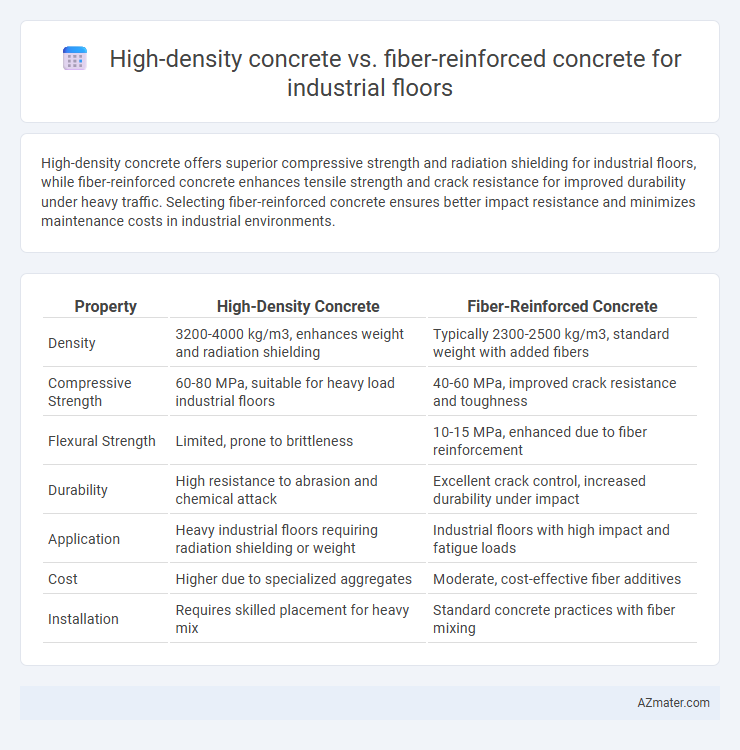High-density concrete offers superior compressive strength and radiation shielding for industrial floors, while fiber-reinforced concrete enhances tensile strength and crack resistance for improved durability under heavy traffic. Selecting fiber-reinforced concrete ensures better impact resistance and minimizes maintenance costs in industrial environments.
Table of Comparison
| Property | High-Density Concrete | Fiber-Reinforced Concrete |
|---|---|---|
| Density | 3200-4000 kg/m3, enhances weight and radiation shielding | Typically 2300-2500 kg/m3, standard weight with added fibers |
| Compressive Strength | 60-80 MPa, suitable for heavy load industrial floors | 40-60 MPa, improved crack resistance and toughness |
| Flexural Strength | Limited, prone to brittleness | 10-15 MPa, enhanced due to fiber reinforcement |
| Durability | High resistance to abrasion and chemical attack | Excellent crack control, increased durability under impact |
| Application | Heavy industrial floors requiring radiation shielding or weight | Industrial floors with high impact and fatigue loads |
| Cost | Higher due to specialized aggregates | Moderate, cost-effective fiber additives |
| Installation | Requires skilled placement for heavy mix | Standard concrete practices with fiber mixing |
Introduction to Industrial Flooring Solutions
High-density concrete offers exceptional load-bearing capacity and radiation shielding properties, making it ideal for industrial floors exposed to heavy machinery and hazardous environments. Fiber-reinforced concrete enhances tensile strength, crack resistance, and durability, improving the floor's lifespan under dynamic loads and thermal stress. Selecting the appropriate concrete type depends on specific industrial requirements such as structural demands, environmental factors, and maintenance considerations.
Overview of High-Density Concrete
High-density concrete is a specialty concrete made with heavy aggregates like barite, magnetite, or hematite, providing densities typically between 3000 and 4500 kg/m3, significantly higher than standard concrete. Its increased mass enhances radiation shielding, impact resistance, and load-bearing capacity, making it suitable for industrial floors in facilities such as nuclear plants, warehouses with heavy machinery, and high-traffic manufacturing environments. The material's durability and compressive strength, often exceeding 50 MPa, contribute to reduced floor thickness and extended service life under severe operational conditions.
Key Properties of Fiber-Reinforced Concrete
Fiber-reinforced concrete (FRC) significantly enhances the tensile strength and crack resistance of industrial floors compared to high-density concrete, improving durability and reducing maintenance costs. The incorporation of fibers such as steel, glass, or synthetic materials provides superior impact resistance and mitigates shrinkage-related damage, crucial for heavy-load industrial environments. FRC also offers better flexural strength and toughness, ensuring longer lifespan and improved safety in industrial floor applications.
Strength and Durability Comparison
High-density concrete features superior compressive strength due to its dense aggregate composition, making it ideal for withstanding heavy industrial loads. Fiber-reinforced concrete enhances tensile strength and crack resistance by integrating synthetic or steel fibers, significantly improving durability under dynamic and impact stresses. Choosing between them depends on specific industrial floor requirements, with high-density concrete excelling in load-bearing capacity and fiber-reinforced concrete providing enhanced toughness and longevity.
Resistance to Chemical and Mechanical Stress
High-density concrete offers superior resistance to mechanical stress due to its increased density and compressive strength, making it ideal for heavy industrial loads and impact durability. Fiber-reinforced concrete enhances toughness and crack resistance by distributing stresses more evenly, improving resilience against repeated mechanical shocks and tensile stress. Both types provide excellent chemical resistance, but high-density concrete's impermeability offers enhanced protection in environments with aggressive chemical exposure commonly found in industrial floors.
Installation Methods and Time Efficiency
High-density concrete requires careful placement using mechanical vibrators and typically longer curing times due to its dense aggregate content, impacting installation speed in industrial floor applications. Fiber-reinforced concrete incorporates synthetic or steel fibers that enhance tensile strength and reduce cracking, allowing for faster finishing and early load capacity without extensive curing delays. Selecting fiber-reinforced concrete often results in improved time efficiency and simplified installation processes compared to high-density concrete in heavy-duty industrial flooring.
Maintenance and Longevity Considerations
High-density concrete offers superior durability and resistance to heavy loads, reducing maintenance frequency in industrial floors exposed to intense mechanical stress. Fiber-reinforced concrete enhances crack control and impact resistance, extending the floor's lifespan by minimizing surface damage and maintenance costs. Both materials contribute to longevity, but high-density concrete is preferable for heavy load applications, while fiber reinforcement excels in flexural strength and crack mitigation.
Cost-Effectiveness and Budget Impact
High-density concrete typically incurs higher material costs due to its use of heavy aggregates like barite or magnetite, making it less cost-effective for large industrial floor projects compared to fiber-reinforced concrete. Fiber-reinforced concrete reduces labor and maintenance expenses by enhancing durability and crack resistance, thereby offering better long-term budget impact. Selecting fiber-reinforced concrete can lead to lower overall expenditures and improved performance in industrial flooring applications.
Environmental and Sustainability Factors
High-density concrete offers superior radiation shielding properties but involves higher cement content, leading to increased carbon emissions and less sustainability compared to fiber-reinforced concrete. Fiber-reinforced concrete enhances crack resistance and durability with reduced cement requirements, lowering its environmental impact through decreased resource use and improved lifespan. Choosing fiber-reinforced concrete for industrial floors supports sustainability goals by minimizing carbon footprint and promoting long-term structural integrity.
Choosing the Right Concrete for Industrial Floors
High-density concrete offers superior compressive strength and radiation shielding, making it ideal for industrial floors exposed to heavy machinery and hazardous materials. Fiber-reinforced concrete enhances tensile strength, crack resistance, and impact durability, providing long-term performance under dynamic loads and frequent traffic. Evaluating load-bearing requirements, environmental exposure, and maintenance needs ensures the optimal concrete choice for industrial floor longevity and safety.

Infographic: High-density concrete vs Fiber-reinforced concrete for Industrial floor
 azmater.com
azmater.com